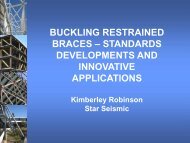Environmental Impacts of Multi-Storey Buildings Using Different ...
Environmental Impacts of Multi-Storey Buildings Using Different ...
Environmental Impacts of Multi-Storey Buildings Using Different ...
Create successful ePaper yourself
Turn your PDF publications into a flip-book with our unique Google optimized e-Paper software.
1.4 Further WorkThe difficulty in maintaining complete objectivity in building assessment systems is most noteablein the material selection criteria and to a lesser extent in the energy use criteria. Definingsustainable materials presents a confounding challenge for Scientists. Ultimately a betterintegration <strong>of</strong> LCA techniques and LCA-based decision support tools in whole building rating andcertification systems is preferable.Based on this study there are several options for further work that would add to the growing body<strong>of</strong> knowledge in this vital research area, some <strong>of</strong> these are detailed below. During the review phase<strong>of</strong> the GreenStar NZ tools provide feedback to the New Zealand Green Building Council aroundalignment <strong>of</strong> the ratings to the initial objective to reduce the flows from and to nature. Data tosupport this important feedback would be essential to ensure changes could be incorporated int<strong>of</strong>uture tools.Once the GreenStar NZ Education tool has been released it may be prudent to re-run the selfassessmentsand compare LCA with the appropriate application-specific green building rating tool.A further study comparing results obtained for similar self-assessments with BREEAM and LEEDas alternate green building rating tools that have had the opportunity to mature in the market.Further work around true life cycle costs for beneficial re-use options for recycled materials andinvestigating barriers to LCA data availability for New Zealand is suggested.Provision <strong>of</strong> research data to companies trying to become <strong>Environmental</strong> Choice certified wouldenable the market to have better data across a wider range <strong>of</strong> products and this would encouragetheir wider use.A more comprehensive treatment <strong>of</strong> other credits where LCA would be invaluable isrecommended, examples include; MAN-7 (quantifying the impact <strong>of</strong> waste diverted from landfill) orEMI-5 (assessing the life cycle costs <strong>of</strong> reducing flows to municipal sewage systems).The issue <strong>of</strong> data availability across borders to ensure comparability and the obvious commercialsensitivity <strong>of</strong> the data is an outstanding issue requiring resolution at a high level. Raising the pr<strong>of</strong>ile<strong>of</strong> LCA as a decision support tool at government level would be fundamental to winning furtherfunding to develop New Zealand-based data. When judging the significance <strong>of</strong> data with respect toreferences or benchmarks the ultimate answer lies in developing case studies <strong>of</strong> different types <strong>of</strong>conventional buildings in different regions that can serve as benchmarks. There are compellingreasons to have this data in terms <strong>of</strong> future pro<strong>of</strong>ing key decisions around climate change andadaptation.In the long run the integration <strong>of</strong> LCA tools into whole building assessment systems will yieldsignificant benefits, not only will it improve understanding and reward for environmentalperformance, but once established future LCA will be less complex and expensive. A paradigmshift is required away from conventional wisdom and related procurement decisions towardminimisation <strong>of</strong> life cycle flows to and from nature.Status Draft 16.07.2008Project NumberOur Ref − MWH Scion GreenStar Assessment PeerReviewFINAL.doc
















